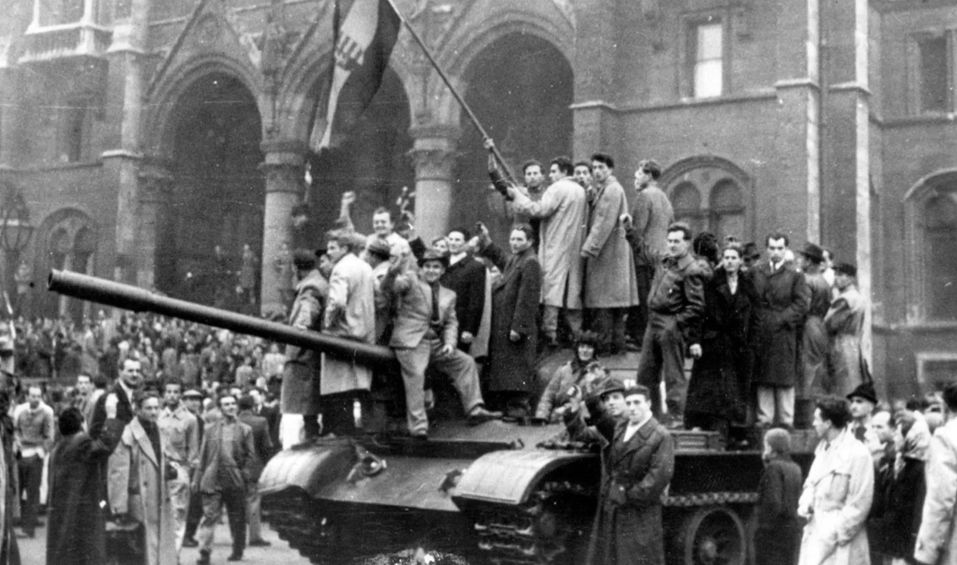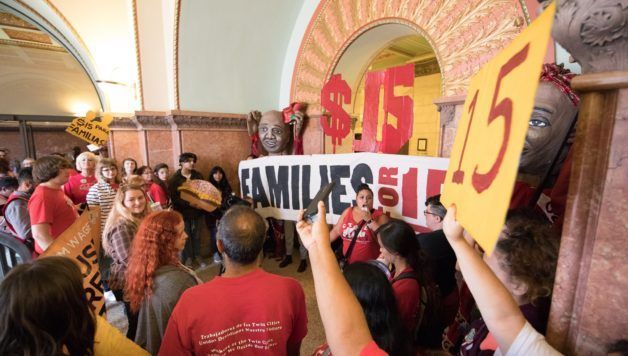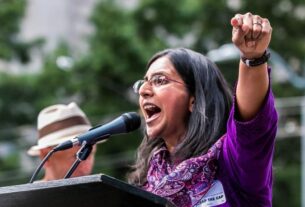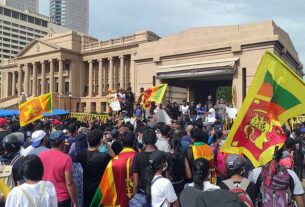Till Ruster is a member of Sozialistische LinksPartei (ISA in Austria).
Sixty-five years ago, on 23 October about 20,000 Hungarians protested in Budapest in support of a manifesto which called for Hungarian independence, democratic socialism based on land reform, public ownership and democratic rights. The Hungarian revolution had started.
A captured Soviet tank is rolling towards a line of police in Budapest. The protesters on the tank are waving the Hungarian Tricolour, but with a circle cut out in the middle, where once the socialist emblem was. Many of the police in the line ask themselves: “Am I on the right side of this? Are those not my friends on the tank?” It’s 23 of October…2006.
The protesters, many of them organized in the fascist “Garda” Militia, were using the 50th anniversary of the Hungarian Uprising of 1956 to protest against the Social-democratic government and push for a new, far-right order. The tank they captured was a part of a memorial for that uprising.
This is a glimpse of how the uprising of 1956 is even today still a very vibrant part of Hungarian political life. After they came to power, the far-right Fidesz government used the anniversary, a national holiday, to hold huge rallies to boost their own support. They were met by tens of thousands of counter demonstrators from various opposition groups. They all, whether the far-right government, the pro-capitalist liberal opposition, or the fascists marching on that day, claim that it is they who are the true heirs of 1956. They are all wrong.
Who can lay claim to the Uprising?
Controversy around the events in 1956 continues. Aside from the domestic situation within Hungary itself, the uprising took place in the context of the Cold War. Many books and movies all interpret those events in their own way.
So, what did happen in 1956 in Hungary? Was it a national uprising against Russian occupation or counter-revolution against a socialist government? Was it an attempted fascist coup d’état or a CIA-conspiracy gone wrong? Maybe it was all due to a power struggle within the Stalinist bureaucracy?
These explanations are pushed by those various political forces that do not want to recognize that the overwhelmingly dominant feature of what happened was a worker’s uprising against Stalinism. Yes, it was full of contradictions and unresolved issues. The hot phase of the uprising lasted only about 12 days, and it did not continue to completion, but the most dynamic factor, the one factor that was the driving force behind the events, the one factor that showed the most potential was the organized working class. From this point of view, the Hungarian uprising was one of the most promising and tragic defeated revolutions in history.
Hungary after 1945
The turbulent events following the end of the second world war, as elsewhere in Europe, meant that socialist ideas grew ever more popular after the defeat of fascism. The first, mostly free elections in 1946 showed a huge victory (57%) for the small Peasants’ Party (KMP), a logical outcome for a mostly agrarian country in which the question of land distribution remained unresolved. But both workers’ parties, the Hungary Communist Party (HKP) and the Social Democratic Party of Hungary (MSZDP ) each received 17%, huge votes for a country with such a small working class.
Under pressure from Moscow, the two parties formally merged to form the Stalinist “Hungarian Working Peoples’ Party” (MDP) although the reality was, that the MSZDP was consumed by the HKP to form a Stalinist dominated party. This was helped by the return to Hungary of thousands of exiles who fled after the defeat of the Hungarian Soviet Republic of 1918/19, or during the 37 years of far-right dictatorship. The newly reformed party grew vastly in membership.
In 1948, in line with the Stalinist approach across Eastern Europe, an “all-party coalition” led by the Stalinist MDP was formed. The newly established Stalinist bureaucracy controlled the political and economic policies, including the forced collectivization of agriculture, while putting enormous resources into the repressive apparatus. The often harsh authoritarian measures, which included press-censorship and election fraud, of the new government do not change the fact, that measures like land reform, the socialization of production, and improved housing were also very popular. The former agrarian state developed into an industrial one over the coming decades. Living standards were rising pretty fast, already by the late 1940s they were higher than they had been before the war.
But the Soviet Union was already exerting economic pressure. Instead of producing consumer-goods for the home market, the economy was turned into a satellite of the Soviet Union, which was trying to maintain a huge army on the borders with the capitalist states.
As support for the effectively one-party rule declined, the regime of MDP-chief Rákosi increased repression. Soon the Hungarian secret police AVH earned notoriety for its brutality even within the Stalinist Block. Thousands were imprisoned, many more were sacked from their jobs or were subjected to other forms of repression.
All this seemed to change again in 1953 with Stalin’s death. Following the new course of Nikita Krushchev in Moscow, the more popular “father of land distribution”, the minister of agriculture Imre Nagy became Prime Minister, although Rákosi remained head of the party, the real head of state. Nagy was able to oversee the softening of repression, but the “popular reformer” and the “hated dictator” were headed for confrontation. In 1955, Nagy lost his position and was even removed from the party. Most of Nagy’s promises remained unimplemented, or were reversed, but people blamed Rákosi for this. Many linked Nagy with their hope for a better and freer living, thinking that if he returned, the power of the AVH might be broken, industry would become more responsive to the actual needs of the population, and working conditions would improve as would be expected in a “workers state”.
When in 1956, Khrushchev made a more serious attempt to remove the old Stalin-Clique from power, Rákosi had to go, but his successor Gerö was from the same stock. Nothing seemed to change in Hungary, at least within the ruling circle.
The first days
In the factories, in the peasant collectives, in the universities, and even within the party rank and file a lot was changing. People were discussing change and more or less openly organizing. Marxist reading circles evolved en mass, especially within the party youth organization. Poetry clubs appeared everywhere, taking up the Hungarian tradition of “hiding” free speech from repressive governments in verse. These informal groups often became very important during the uprising. And the uprising was due: without any democratic structures in the state or the party there was no other way.
Workers in other countries had already provided inspiring examples. In 1953 East German workers went on strike. In 1956 Polish Workers did the same. The first day of the Hungarian uprising, 23 October 1956, started with a demonstration organized by the communist youth in Budapest in support of the strike in Poland. But their demands were already focused on Hungarian issues. The official demands included a nationally independent socialist course for Hungary, equality between the socialist states, equal treatment of all national minorities, workers’ control over factories, and Nagy instead of Rákosi as head of the government. These demands were crucial and very successful in mobilizing tens of thousands of workers to join the demonstration. Events started to unfold.
In a panic, the government tried to crush the movement. Its first attempt using the national army saw many of them going over to the side of the protesters. Then they tried the AVH, but their extreme violence escalated the movement. It was defeated and members of the AVH were often lynched. Finally, the Russian Army, which had been stationed around Budapest was sent in.
This was only possible because the Soviet Army Command told the soldiers they were to fight fascist thugs, that the Hungarian people were crying out for their help to defeat the fascists once again. But when Soviet troops arrived in their tanks, they met mostly unarmed people being shot at by the secret police. A conscious approach was made by some protesters to talk to the soldiers, very often with success. The soldiers mostly refused to fight the protesters, often even offering to hand their weapons over so they could fight back against the AVH. The Soviet Army was withdrawn to the barracks and the government, now undefended, restored Nagy as head of the state.
But it was too late to solve the issue with political maneuvers. The masses had got a taste of their power and went on fighting for their demands. The movement overnight erupted across Hungary, but was the strongest in the industrial centers in the west. Many thought that Nagy now needed protecting in the form of an uprising against the old Rákosi-clique, and even more against the pressure from Moscow. But in fact, the more the movement radicalized, the more Nagy was pushed to go further and further every day. Nagy, after all, was a bureaucrat himself. A reformer, yes, but no revolutionary. Every move he made was reluctant, trying to find solutions on the diplomatic level and trying desperately not to rely on the dynamics of the masses. The Hungarian Uprising or Revolution of 1956 had a bad leader in Nagy and as events unfolded Nagy became more of a hindrance than a leader.
The backbone of Revolution
While the weakness of the movement lay in the leadership at the national level and the political confusion that came with it, its strength was its high level of organization, considering the short time it had to build it up. All over Hungary Councils spread of Workers, Peasants, Soldiers, Neighborhood or Regions. It is impossible to give exact figures, but some estimate that up to 5,000 of such councils existed with more than 50.000 members.
It is this high level of organization, combined with the political demands calling for an end to dictatorship and for genuine democratic socialism that defines the real nature of the Hungarian revolution. Peter Fryer was in Hungary as correspondent of the British Communist Party paper “Morning Star”. In one of his reports he wrote:
“If the Soviet intervention was necessary to put down counterrevolution, how is it to be explained that some of the fiercest resistance of all last week was in the working-class districts of Újpest, in the north of Budapest, and Csepel, in the south — both pre-war strongholds of the Communist Party? Or how is the declaration of the workers of the famous steel town of Sztálinváros to be explained: that they would defend their Socialist town, the plant and houses they had built with their own hands, against the Soviet invasion?”
Yes of course, as the uprising broke out, different political forces tried to use the opportunity. This included a number of left, pro-land reform and anti-fascist parties which had been suppressed first by the fascist regime, and then by the Stalinists. Hundreds of right-wing emigres returned, with the hope of fighting the Soviet troops. The western governments, and through their mouthpiece “Radio Free Europe” implied that they would help the uprising if Soviet troops intervened, but did absolutely nothing when it actually happened.
But these were not the dominant features of the uprising, particularly when compared to the potential power of the council-movement and their effect on the events. As the old order collapsed, they moved in, organizing security, healthcare and transportation. In these few days, the councils became the most important force in Hungary, without their support the Nagy government would not have survived for a day. Although they, and the workers they organized, lacked a full program for political revolution, and they did not have enough time to become fully coordinated and organized, their demands were quite consistent and close to the original agenda of the communist youth who initiated the protests.
They did not want the restoration of capitalism, they wanted a democratic socialism. How that would look was hotly debated, but critical was the need for Hungary to escape from domination of Stalin’s dictatorship.
This was expressed by Colonel Maléter, one of the most interesting figures of the revolution, who then became minister of defense in the Nagy government. On the first day of the uprising, he ordered his tank regiment that had been sent to crush the revolt to instead defend the workers from the hated AVH. He said
“if we get rid of the Russians, don’t think we’re going back to the bad old days. And if there are people who do want to go back, well we shall see” and then he tipped his fingers on his revolver”*.
Counter Revolution
But this was not to be. After some fake negotiations to gain time for the Russians to bring in units that were not affected by the revolutionary mood in the country, fighting started again on 4 November. The Kremlin bureaucracy was extremely afraid of the events in Hungary. Not only was their grip on the other satellite states in danger, a victorious uprising would have created an alternative, much more attractive socialist society, that could have won the support of workers and youth in the other Stalinist states of Eastern Europe, and could easily have led to the collapse of Stalinism in the Soviet Union. Fearful that the days of the bureaucracy could be over, the Stalinists did everything in their power to sabotage and destroy the revolution, just as they had already done elsewhere.
The Soviet Army met a very well-organized resistance, not just by heroic individuals but by whole regiments of mutineer Hungarian Army soldiers and militia units. By now, the Council-movement had become a military body, keeping up the fight for almost two weeks, as many Hungarians waited for the promised military support from the US, or maybe from Yugoslavia, which was itself in conflict with Moscow. But nobody came.
Despite its military defeat, the uprising did not die immediately. The councils still continued to meet for a period even when the state was back under full Stalinist control. The political support for the councils amongst the masses proved too strong for them to just be dissolved. On November 21 an attempt was made to establish a national Workers Council in Budapest, a new potential counter-government. When the state stopped the delegates from meeting, a general strike was called. But by now, the workers were tired and the people starving. Some promises were made by the government and the strike petered out. After one last 48-hour general strike in January the movement was finally defeated.
Many of the leaders were executed or imprisoned. Over 200,000 Hungarians fled to the west to avoid the brutal repression after the uprising.
Remembering is fighting
Today over 600,000 Hungarians work or live outside of Hungary. They do not flee from violence and repression but from poverty and the “illiberal” democracy of Viktor Orbán. Capitalist restoration and the so called “mafia state” led by Viktor Orbán are depriving Hungarians, especially the youth of any perspective of a bright future. Orbán tries to overcome this by leaning on patriotism. His nationalistic version of the events from 1956 still plays an important role in it.
But it’s the working class that actually has the right to this history and has much to learn from it. This is Orbán’s biggest fear, and explains why so many anti-labour laws and repression against strike movements have been used in the recent past. A wannabe dictator like Orbán has nothing to hold the working class back once it reclaims the stage. Their organized resistance in a small country shook even the powerful Soviet Union and is an inspiration to workers and youth who still have to fight against authoritarian regimes today.
* Sebestyen, Victor, Twelve Days: Revolution 1956.




